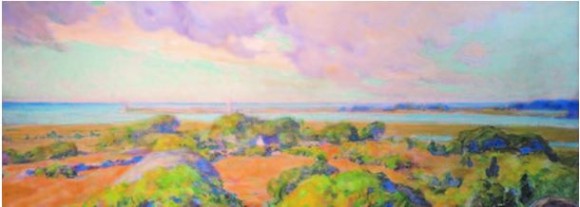
The Connecticut River Estuary Lecture Series hosted by the Connecticut Audubon Society continues this evening, Thursday, June 4, with a presentation titled, “Aesthetic Beauty of the Estuary: Vision of Artists and Writers,” at Essex Meadows starting at 4 p.m.
Jeffrey Cooley, founder and owner of The Cooley Gallery in Old Lyme. will give the lecture, which will look at the role of the estuary in painting and writing.
The first two lectures of the Connecticut River Estuary series have been terrific successes, with over 100 people attending each one.
Admission to the lecture is free but RSVP’s are required. To RSVP, contact Allison Bryant at the Connecticut Audubon Society at [email protected] or 203 259-0416 x106. A reception follows each lecture.
For more information on the lecture series, visit www.ctaudubon.org/2015/04/connecticut-river-estuary-lecture-series/.
These lectures are one of the initial projects of a new regional board formed by the Connecticut Audubon Society to focus on the lower Connecticut River valley and southeastern Connecticut.
The new board will work in conjunction with Connecticut Audubon Society staff and state Board of Directors to provide direction and support to the organization’s conservation and education work in Old Lyme, Lyme, Essex, Old Saybrook, and other communities in southeastern Connecticut.
The board’s other seminal projects include the introduction of Connecticut Audubon’s award-winning Science in Nature outdoor education program at Essex Elementary School and an effort to expand Osprey Nation, Connecticut Audubon’s citizen science Osprey monitoring program.
For decades Connecticut Audubon Society has maintained nature sanctuaries in Montville, Haddam, East Haddam, Stonington and Middletown. In addition to being a key component of the region’s native habitat, the sanctuaries serve as portals of opportunity into nature for children and families in the region.
The chair of the new Regional Board is Herman Blanke of Old Lyme. Other members are Patsy McCook (secretary) of Old Lyme; Emily Bjornberg of Lyme; Elsie Childs of Old Lyme; Jim Denham of Essex; Margarita Emerson of Niantic; Eleanor Robinson of Old Lyme; Dr. Ted Vanitallie of Old Lyme; and Claudia Weicker of Old Lyme.
Herman Blanke and Jim Denham are also members of Connecticut Audubon Society’s Board of Directors.
In addition, Old Lyme resident John Forbis and Old Lyme First Selectwoman Bonnie Reemsnyder have provided essential support to this effort.
“Having had the fortune to live in Essex for 15 years, I have always appreciated the values of the Connecticut River; its incredible aesthetic beauty, its ecological contributions, and its great historical legacy to the people of this nation., said Alexander Brash, president of Connecticut Audubon Society.
He continued, “In keeping with the great tradition of conservationists of the area, we are looking to work with its citizens and school children in order to highlight and protect the area’s birds, unique biodiversity and habitats, and leverage such interactions for greater awareness of conservation issues across the state.”
“There is a great conservation tradition to uphold in this region,” said Herman Blanke. “Roger Tory Peterson of Old Lyme helped make birding the popular pastime that it is and also drew the connection between birds and conservation. A century ago, the painters of Old Lyme turned this beautiful landscape into art. We view it as our goal and our responsibility to carry on that tradition of conservation and appreciation for the beauty of the natural world.”
Jim Denham said, “From its inception, Connecticut Audubon Society has made conservation education the foundation of its work. Each generation is responsible for helping the next generation understand how the natural world works and why conservation is important, and for making sure the wonders of nature don’t get lost amid all the distractions of the modern world. That’s what we are trying to accomplish at Essex Elementary School, and we intend for it to be a stepping stone to collaborations with other schools as well.”
Science in Nature, which provides curriculum-based outdoor science education to students in elementary and high schools, recently completed its first session at Essex Elementary, with a field trip to Chatfield Hollow State Park in Killingworth. The second session is set for May 28 at Hammonasset Beach State Park in Madison.
Science in Nature teaches the principles of conservation science in local outdoor settings, focusing on climate and weather, rocks and soils, ecological adaptations, and wetland ecology. The goal is to increase environmental literacy among elementary, middle and high school students so they will understand basic environmental science principles and be more likely to participate in finding solutions to environmental issues within their communities.
In October it was named the best outdoor conservation program in the region by the New England Environmental Education Alliance. Schools from almost 50 communities in Connecticut have participated in Science in Nature, although Essex Elementary is the first in southeastern Connecticut to take part.
Osprey Nation uses volunteer citizen scientists, working under the direction of Connecticut Audubon’s conservation staff, to find and monitor nests of the state’s resurgent Osprey population.
More than 400 Osprey nests have been identified and plotted on a map. The greatest concentration in the state is on Great Island in Old Lyme. Connecticut Audubon is hoping that increased awareness of the project will propt more local residents to volunteer to as Osprey stewards in Old Lyme and elsewhere throughout the southeastern part of the state.
Founded in 1898, Connecticut Audubon Society is the state’s original and still independent Audubon Society. The Society manages four nature centers, two museums, and 19 sanctuaries across the state. It uses the charismatic nature of birds to inspire the next generation of conservationists, and to work with the current generation to protect and improve the state’s natural habitats for the betterment of state residents, birds and other wildlife.
Connecticut Audubon Society’s headquarters are at Birdcraft Sanctuary in Fairfield. It has regional centers and associated boards in Fairfield, Pomfret, Glastonbury and Milford.